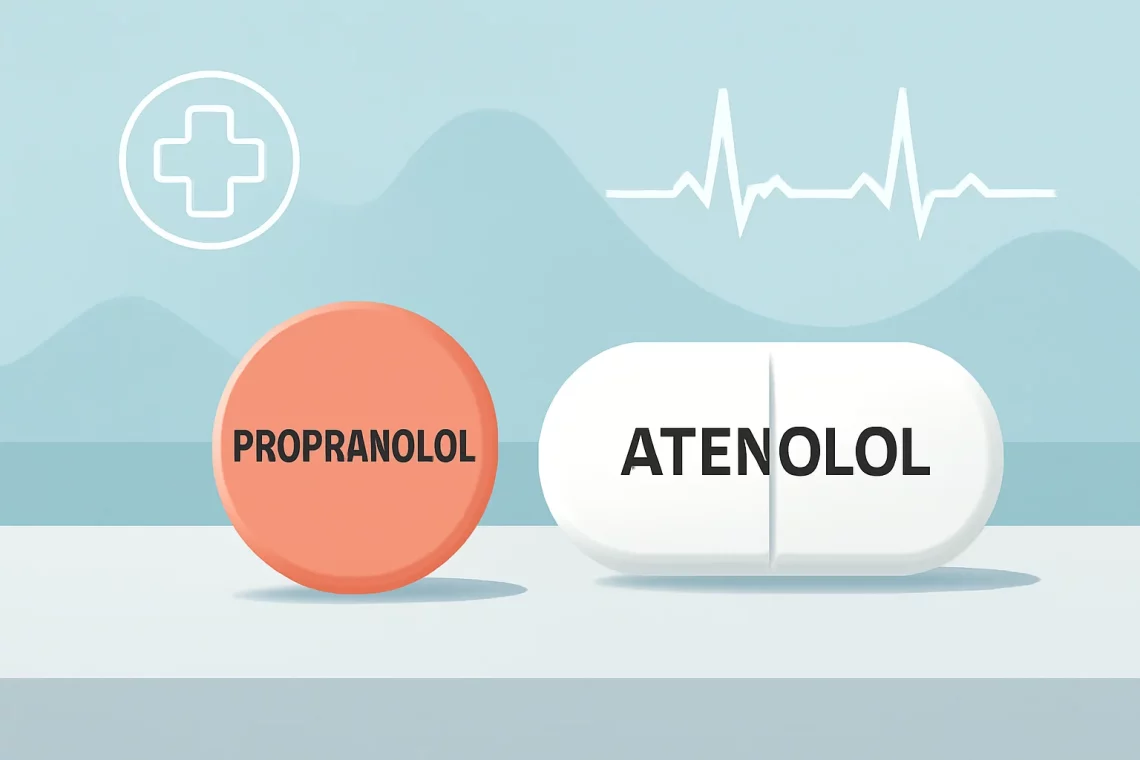
Propranolol vs Atenolol: Which Beta-Blocker Is Right for You?
Propranolol and Atenolol are two widely prescribed medications that belong to the class of drugs known as beta-blockers. These medications are primarily used to manage various cardiovascular conditions, such as hypertension, angina, and arrhythmias. They can also be effective in treating other conditions, including anxiety and migraine prevention. Both drugs work by inhibiting the effects of adrenaline on the body’s beta receptors, which leads to a decrease in heart rate and blood pressure. Despite their similarities, Propranolol and Atenolol possess distinct pharmacological properties and clinical applications that can influence a physician’s choice of treatment. Understanding these differences is essential for patients and healthcare providers alike, as it can significantly impact treatment outcomes and overall quality of life.
The choice between Propranolol and Atenolol may depend on a variety of factors, including the specific health condition being treated, patient history, potential side effects, and individual response to the medication. In this article, we will explore the various aspects of Propranolol and Atenolol, comparing their uses, mechanisms of action, side effects, and more.
Mechanism of Action
Both Propranolol and Atenolol function as beta-adrenergic antagonists, but they differ in their selectivity and effects on the body. Propranolol is a non-selective beta-blocker, meaning it blocks both beta-1 and beta-2 adrenergic receptors. This characteristic makes Propranolol useful in a wide range of conditions, from hypertension to anxiety disorders. By inhibiting the beta-1 receptors in the heart, Propranolol reduces heart rate and contractility, leading to lower blood pressure and reduced myocardial oxygen demand. Additionally, its action on beta-2 receptors in the lungs can lead to bronchoconstriction, which might be problematic for patients with asthma or chronic obstructive pulmonary disease (COPD).
In contrast, Atenolol is a selective beta-1 blocker, primarily affecting the heart without significantly impacting the beta-2 receptors found in the lungs and blood vessels. This selectivity makes Atenolol a more suitable choice for patients with respiratory issues, as it is less likely to cause bronchoconstriction. Atenolol’s mechanism of action also involves lowering heart rate, reducing myocardial oxygen consumption, and decreasing the secretion of renin from the kidneys, which contributes to its blood pressure-lowering effects.
The choice between these two medications often hinges on the specific clinical scenario. For instance, Propranolol may be the preferred option for patients experiencing performance anxiety due to its ability to mitigate physical symptoms such as tachycardia and tremors. Conversely, Atenolol might be a better choice for a patient with a history of asthma or COPD, as its selective action minimizes the risk of exacerbating respiratory issues.
Clinical Applications
Propranolol and Atenolol are both effective in managing a variety of cardiovascular conditions, but their clinical applications can differ. Propranolol is often used in the treatment of hypertension, angina pectoris, and certain types of arrhythmias. Moreover, it is commonly prescribed for migraine prophylaxis and managing symptoms of anxiety, particularly in situations that trigger performance anxiety or panic attacks. Its versatility makes Propranolol a go-to medication for a range of conditions beyond cardiovascular issues.
Atenolol, on the other hand, is primarily indicated for hypertension and angina. It is also effective in reducing the risk of cardiovascular events in patients who have suffered a myocardial infarction. While it can be used to manage arrhythmias, it is not typically the first choice for anxiety or migraine prevention. Atenolol’s selective action on beta-1 receptors makes it particularly useful for patients with existing respiratory conditions, where non-selective beta-blockers like Propranolol may pose risks.
When considering the treatment of hypertension, both medications can be beneficial, but their efficacy may vary based on individual patient factors. Some studies suggest that Propranolol may be more effective in reducing anxiety-related hypertension, while Atenolol is often preferred for its favorable side effect profile in patients with comorbid conditions such as asthma. Ultimately, the choice of drug will depend on the patient’s overall health, the specific condition being treated, and the presence of any contraindications.
Side Effects and Considerations
Like all medications, both Propranolol and Atenolol come with potential side effects that patients should be aware of. Propranolol’s non-selective nature can lead to a range of side effects, including fatigue, dizziness, and gastrointestinal upset. More concerning are its potential respiratory effects, which can exacerbate asthma or COPD symptoms. Other side effects may include sleep disturbances and cold extremities due to reduced blood flow.
Atenolol, with its selective action, tends to have a more favorable side effect profile, particularly in patients with respiratory concerns. Common side effects include fatigue, dizziness, and bradycardia (abnormally low heart rate). While it is generally well-tolerated, some patients may experience depression or sexual dysfunction.
When prescribing either medication, healthcare providers must consider the patient’s medical history, current medications, and lifestyle factors. For instance, a patient with a history of depression may be more suited to Atenolol, while a patient experiencing significant anxiety symptoms may benefit more from Propranolol. The potential for drug interactions is also a critical consideration, as both medications can interact with other drugs, affecting their efficacy and safety.
Patients should communicate openly with their healthcare providers about any existing health conditions and any side effects they experience while taking these medications. Regular follow-up appointments can help ensure that the chosen treatment remains effective and safe over time.
Conclusion
In conclusion, Propranolol and Atenolol are both effective beta-blockers with distinct characteristics that make them suitable for different clinical applications. Propranolol’s non-selective action allows it to address a broader range of conditions, including anxiety and migraines, while Atenolol’s selective beta-1 blocking provides a safer option for patients with respiratory issues.
Understanding these differences is crucial for both patients and healthcare providers to make informed decisions about treatment options. While both medications offer significant benefits in managing cardiovascular conditions, the choice between Propranolol and Atenolol should be individualized based on patient-specific factors.
As always, it is essential for patients to consult with healthcare professionals regarding their treatment options and to report any side effects or concerns they may have.
**Disclaimer: This article is not intended to provide medical advice. Please consult your healthcare provider for any medical concerns or questions related to medications.**




